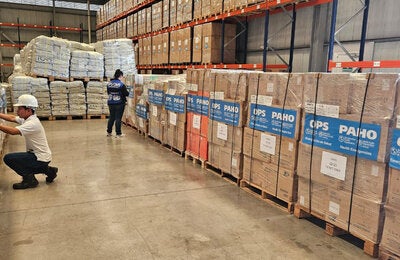On World Tuberculosis Day, PAHO/WHO invites government, health sector, and civil society leaders and patients to take the necessary action to end this disease, which kills more than 20,000 people each year in the Region.
Washington, D.C., March 23, 2018 (PAHO/WHO) -Although significant progress has been made in reducing tuberculosis cases in the Region of the Americas, leaders from all sectors are needed to end this disease by 2030, according to the Pan American Health Organization/World Health Organization (PAHO/WHO).
On World Tuberculosis Day, observed every March 24, PAHO/WHO is calling on all sectors at all levels, from governments to communities and civil society, to work together and spearhead efforts to meet the goal of eliminating this disease.
Tuberculosis was responsible for an estimated 23,226 deaths in the Region of the Americas in 2016, with 222,750 new cases reported that year. However, each year, around 50,000 people with TB are not diagnosed; consequently, they do not receive timely treatment and can infect others, thus perpetuating the disease. Furthermore, over 30,000 people with HIV developed tuberculosis in the Region in 2016.
"We can end tuberculosis in the Region of the Americas. We must address the factors that lead to this disease, ranging from living conditions to health service access barriers,"declared Marcos Espinal, Director of the Department of Communicable Diseases and Environmental Determinants of Health of PAHO/WHO. "We need committed leaders in each sector of society who will take action to meet this goal," he stressed.
Since 2000, the tuberculosis incidence rate (new cases) in the Americas has declined by 1.7% annually, largely due to the measures adopted by the countries of the Region, in line with the WHO global END TB Strategy and the PAHO Plan of Action for the Prevention and Control of Tuberculosis.
However, to meet the goal of ending the tuberculosis epidemic by 2030, as called for in the United Nations Sustainable Development Goals, the rate of new cases must be reduced by 5.3% annually. Currently, there are an estimated 27 new TB cases per 100,000 population in the Americas annually.
Challenges
The populations generally at highest risk in the Americas are people with HIV, people in street situations, residents of marginalized urban areas, people deprived of liberty, people with addictions, and populations with limited access to health care. Some 80% of the affected population lives in urban areas, and the rapid growth of cities can facilitate transmission of the disease.
Even though TB is curable and preventable, it is estimated that more than 23,000 people in the Americas died of this disease in 2016.Immunosuppressed people-for example, individuals suffering from HIV, malnutrition, or diabetes and smokers- are at higher risk of contracting it.
Resistance to the tuberculosis drugs that have been used for decades is another challenge that has emerged in recent years.In 2016, while estimates put the number of multidrug-resistant TB cases in the Americas at 8,100, only 46% were diagnosed.
Other challenges include the introduction of new rapid diagnostic technologies such as GeneXpert, new medicines such as dispersible pediatric drugs and short-course treatments for MDR-TB, and the expansion of initiatives to provide treatment for vulnerable populations, such as the one for TB control in large cities.
"Leaders for a TB-free world"
In order to tackle these challenges, this year's campaign for World Tuberculosis Day calls for "Leaders fora TB-free world." It focuses on securing the commitment to end tuberculosis, not only at the political level among heads of state, but at all levels, from mayors, governors, parliamentarians, and community leaders to people with tuberculosis, members of civil society, health workers, physicians, nurses, and other partners in the response.
This is critical for securing the necessary commitments for the United Nations High-level Meeting on Tuberculosis slated for September of this year, where Heads of State will discuss the action necessary for accelerating implementation of the End TB Strategy and ending the disease by 2030.This meeting follows the Global Ministerial Conference on Ending TB in the Sustainable Development Era, held last November in Russia. In the resulting Moscow Declaration to End TB, the health authorities of 120 countries committed to accelerating progress to end tuberculosis.



